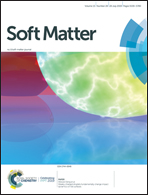Relative contributions of chain density and topology to the elasticity of two-dimensional polymer networks
Abstract
Understanding the relationships between the structure of polymer networks and their mechanical properties is important for the design of advanced soft materials with optimal properties. However, classical rubber elasticity theories often fall short in their description of the network structure, while simulation techniques at molecular scale remain impractical at that length scale. Here we develop a computational approach based on random discrete networks, in which the polymer network is represented as an assembly of non-linear springs connected at crosslinking points. The density of elastically-effective chains, average network coordination and chain contour lengths are varied independently in order to identify their respective contributions to the network elasticity. Numerical results suggest scaling relations between network parameters and elastic properties that are markedly different from the predictions of classical rubber elasticity theories. In particular, the elastic modulus of 2D random networks is found to be independent of density at constant topology, and proportional to the average coordination at constant density. The discrepancy is due to the pre-straining of the chains in the discrete network, which is not accounted for in classical models of rubber elasticity. Our results have implications for the interpretation of experimental data for ideal network gels that are formed by the cross-coupling of macromolecular building blocks in solution.



 Please wait while we load your content...
Please wait while we load your content...